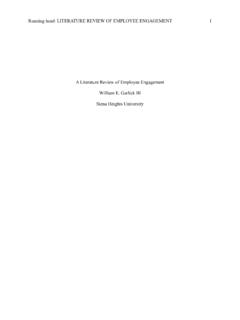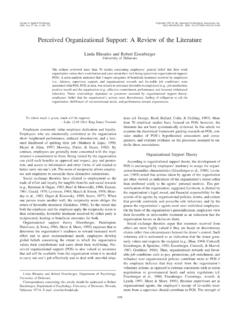Transcription of The Impact of Employee Engagement on Job Performance …
1 Journal of Business and Management Sciences, 2015, Vol. 3, No. 5, 138-147 Available online at 5/ 1 Science and Education Publishing The Impact of Employee Engagement on Job Performance and Organisational Commitment in the Egyptian Banking Sector Maha Ahmed Zaki Dajani* Business Department, British University, Cairo, Egypt *Corresponding author: Abstract During the past two decades, Employee Engagement became a very popular managerial construct. Organisations use different Engagement building tools in order to stay competitive and improve Performance . Though there is an increasing contribution in human resource consulting agencies on the concept of Employee Engagement , yet there is a shortage of academic studies on that construct, especially in emerging economies countries. This Engagement gap grew more in importance amidst the waves of ongoing recession and resource scarcity battles prevailing in the Middle Eastern Region, in general, and in Egypt in particular.
2 This is an exploratory study that aims to identify the key drivers of Employee Engagement within the Egyptian context. It also studies the Impact of Employee Engagement on job Performance and organisational commitment based on social exchange theory (SET). A survey questionnaire was developed and validated. Regression analysis was used to predict and explain the proposed relationships. The study was conducted on 245 bank employees from several private and public banks operating in Cairo-Egypt with a response rate of about % ( 200 employees) Pearson correlation matrix and regression were used to predict and estimate the relationships. Regression results indicated that leadership and organisational justice were the most significant drivers of Employee The mediation effect was confirmed. Employee Engagement had significant Impact on job Performance , but less Impact on organisational commitment.
3 This study adds to the very few academic studies that have empirically investigated a comprehensive model of Employee Engagement drivers and outcomes. To the best of the author's knowledge, such a study is the first of its kind undertaken in the Egyptian context. Keywords: Employee Engagement , leadership, organisational justice, job Performance , organisational commitment Cite This Article: Maha Ahmed Zaki Dajani, The Impact of Employee Engagement on Job Performance and Organisational Commitment in the Egyptian Banking Sector. Journal of Business and Management Sciences, vol. 3, no. 5 (2015): 138-147. doi: 1. Introduction Employee Engagement is conceptualized as the individual's investment of his complete self into a role [54]. Engagement is a positive attitude where an individual goes above and beyond the call of duty, so as to heighten the level of ownership, and to further the business interest of the organisation as a whole [75].
4 Moreover, it is also a discretionary effort or a form of in-role or extra role effort or behavior that fosters change [61], and practically affects the Employee morale, productivity, commitment, loyalty to internal and external customers, Employee absenteeism and turnover in the organisation [20,27]. Thus, Employee Engagement has been popularized by practitioners as well as the research/academic community and is regarded as the barometer that determines the association of the individual with the workplace [83]. There remains an academic knowledge gap in Employee Engagement literature, which continuously elicits the need for further empirical research in this area within diverse contexts and different demographic segments. Egypt remains an emerging economy country where the term and practice of Employee Engagement is still under researched. Explicitly, this study attempts to fill this Engagement gap.
5 To do so, it explored five drivers and two outcomes of Employee Engagement amongst employees working in both public and private banks in Cairo Egypt. The five drivers of Employee Engagement were namely: leadership, organisational justice, compensation, work policies and procedures, training & development. Job Performance and organisational commitment were the two tested outcomes of Employee Engagement . Egypt's banking sector continues to play a pivotal role in the development of country's economy. According to year 2013 fiscal statistics of The Central Bank of Egypt there are 40 operating banks in Egypt, 8 public banks, 12 national banks and 20 foreign banks [87]. 2. Objective of the Study To identify key factors affecting Employee Engagement in the Egyptian banking sector. 139 Journal of Business and Management Sciences To investigate the relationship (if any) between Employee Engagement , job Performance and organisational commitment.
6 To suggest best practices needed to improve Employee Engagement and address the so-called ' Engagement -gap' in the Egyptian working culture. 3. Literature Review Employee Engagement Defined The verb to engage has many meanings, varying from a straightforward emotional state of being 'in gear', that is being involved and committed, to another transactional state of working in return for a fair economic exchange at workplace [77]. There are differences among attitude, behaviour and outcomes, in terms of Engagement . As Employee might perform with pride and commitment (attitude); exhibit three positive behaviours, namely Say (employees speak positively about the organisation to others inside and out), Stay (employees display an intense desire to be a member of the organisation) and Strive (employees exert extra effort and engage in behaviours that contribute to business success) [49].
7 Outcomes may then lead to sustainable business success. Considerable studies have shown the existence of a statistical positive relationship between Employee Engagement and business productivity, profitability, Employee retention, safety and customer satisfaction [21,26,49,68]. All these three dimensions attitudes, behaviours and outcomes need to be perceived as part and parcel of the ongoing Engagement process [60]. The term Employee Engagement , coined by the Gallup Research group, remained attractive for three main reasons. First, as mentioned previously, Employee Engagement is interwoven significantly with crucial business outcomes. An organisation with 'high' Employee Engagement might therefore be expected to outperform those with 'low' Employee Engagement , all else being equal [32,90]. According to Gallup's study that was conducted on 142 countries in year 2014, results showed that 13% of Egypt's employees are "engaged" and psychologically committed to their jobs and likely to be making positive contributions to their organisations.
8 Whilst, 55% of Egypt's employees are "not engaged" meaning they lack motivation and are less likely to invest discretionary effort in organizational goals or outcomes; and 32% are "actively disengaged" indicating" they are unhappy and unproductive at work and liable to spread negativity to coworkers [39] This means that roughly 87% of Egyptian employees in the workforce are not fully engaged or they are disengaged. This may account for Egyptian employees' productivity gap and the on-going national economic hardships [47,89]. Second, Employee Engagement mirrored the growing importance of human capital and psychological involvement of employees in business [86]. Businesses have no choice but to produce more output with less Employee input. In trying to do so, corporates need to engage not only the physical body, but also the mental mind and the innate soul of every individual Employee .
9 Third, the increasing scientific interest in positive psychological movement research that aims to discover and promote the factors that allow individual, organisation, and societies to grow and provide the required fertile ground that encourages the growth of Engagement research in academia [77]. The concept of Engagement as a multi-dimensional construct was first introduced by Khan in 1990, the academic pioneer of the Employee Engagement movement. Personal Engagement was defined as the harnessing of employees ' selves to their work roles where they express themselves physically, cognitively and emotionally during role performances [53]. To explain said phenomenon, reference [53] associated three psychological conditions demonstrated in the work role Performance , viz. meaningfulness (feeling that one is receiving a return on the investment of the self), safety (a sense of being able to show and employ the self in the work role Performance without the fear of negative consequences ), and availability (a sense of possessing the physical, emotional and psychological resources needed at work).
10 Kahn s model was then tested and findings supported that the psychological conditions of meaningfulness, safety and availability are positively linked to Engagement [65]. Burnout researchers defined Engagement as the positive antithesis of burnout [62,63]. However, reference [78] took a different perspective to define work Engagement as a state of mind characterized by vigour (energy and mental resilience), dedication (feeling proud about one's job and inspired by it) and absorption (feeling of contentment while performing work). Further on, Saks' comprehensive model on antecedents and consequences of job Engagement (work role), and organisation Engagement (employees' role as members of an organisation) was tested and validated [76]. Another study presented a hierarchical model of Engagement similar to Maslow s hierarchy model of need [71].





